|
There it was!—the legendary South Pacific train, pulled into the stunning
Beaux-Arts railway station in thriving West Oakland. It stood ready with its expert crew, spiffy porters and graceful maids to take passengers in style and comfort to
destinations across the young nation! And here is its cheerful conductor now!
It is a testament to the illusion of this clever and moving installation-event that we were actually sitting in our
cars in the disused parking lot of the abandoned train station in an especially sorry part of town. The images of the train were projected onto the front of the building, along
with slides of the historic station, gleaming tracks, maps of the routes, newspaper headlines.
Late in 2020, our county expanded its Covid health orders to allow heavily regulated "vehicle-based gatherings." Drive-in theatre was a natural
outgrowth, reminiscent of the beloved drive-in movies (and drive-in restaurants) of the 1950s and 1960s. But now, we had to stay in our cars, windows up, with the show's
soundscape transmitted through our car radios. In the world of drive-in theatre, instead of clapping, we honk our horns.
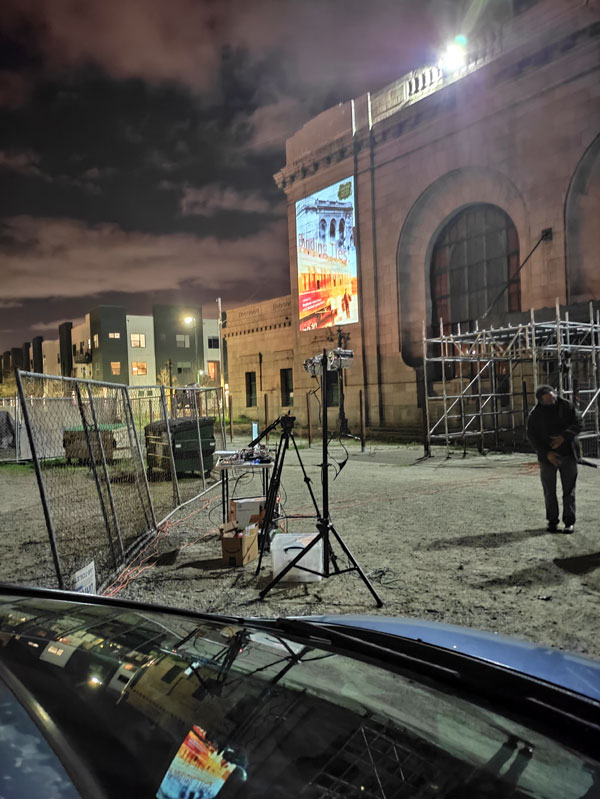
The event site and adjacent neighborhood, seen from inside the car.
Photo L.T. Renaud.
Binding Ties: The 16th Street Station was a perfect outdoor
show for just this expanded health order. Brainchild of the impressive Stephanie Anne Johnson with Michael Sydnor in 1991, the show was
ready for a drive-in, 30th anniversary production by the Oakland Theatre Project. Dr. Johnson has used her 40 years of experience as a
lighting designer—local, national, and international—to bring into view people who have been "forgotten" by our culture, with particular focus
on, and tireless contributions to, recognition of African Americans. She is well-known for her slide projection pieces which, she says, "combine
the ethereal nature of light and the solidity of architecture to symbolize a balance between the spiritual and material worlds." In this case,
Johnson employed her signature tools—light, historical artifacts, archival photographs and live narration—to evoke the early- to mid
-20th century ghosts of the Southern Pacific Railway and its people, as seen through the lens of the 16th Street Station.

A glimpse of the interior of the station, prized for its dramatic
arched windows.
Inside and out, the decaying Landmark begs for a theatrical event. Built in 1912 as the West Coast terminus of the network of railroads
that first started expanding across the U.S. from the 1860s to the 1880s, in its heyday the station saw around 400 trains per day. The area
around the station featured lovely Victorian houses—many still standing—and from the 1940s to the 1960s, had a hopping, nationally
recognized jazz and blues scene that drew top players from around the country. This area was tragically divided by various construction
projects done right through it, including a freeway (1955) and elevated tracks for a new subway (1974). The 16th St. station was badly
damaged in the Loma Prieta earthquake (1989); newer train stations grew up in surrounding areas (1994), and 16th St. saw its last train in
1994. Since then, it's been closed to the public, on the shortlist of Most Beautiful Abandoned Stations in the World, a site for squatters and
taggers, a magnet for daredevil photographers, a film location, and since 2005, the object of architectural preservation efforts to restore it
as a community center and performance venue.
Actor W. Oliver III as the narrating Conductor. Video by Kiril Bolotnikov.
Sitting outside in the dark, 1930s country blues came through the
radio, setting the mood. After some time, the fellow on the right in the poster seemed to materialize in front of us. This was Oakland Theatre
Project's William Oliver III, the only live actor in this production (a live actor a novelty after innumerable shows streaming!) seen in recent productions of Arthur Miller's Death of a Salesman and Shakespeare's A Midsummer Night's Dream. Here, Oliver was The Conductor, whose
narration at beginning and ending gave the show its frame.
On a larger historical scale, the show told the story of the internal migration of Black Americans from the southern states to Oakland for
jobs on the railroad: construction, switch operation, track maintenance, and more. When the Civil War ended in 1865, the Pullman line of
luxury sleeping cars snapped up freed slaves and other Blacks who were initially willing to work as porters for a pittance. Over time, the
courtesy and efficiency of these porters became the shining face of elegant train travel in America; in 1925, the porters began their more
than ten-year struggle for decent wages and working conditions to become the first African American labor union in the United States: the
Brotherhood of Sleeping Car Porters. This hard-earned success in 1937 was achieved at a time when Blacks in the U.S. were still segregated in
public places, a policy chipped away at in diverse places in America over the years, and then officially "ended" by the Civil Rights Act of
1964. It is this haunting history that the country still grapples with today in its social justice movements and, without mentioning them, makes the story told in Binding Ties not only informative but crucial.
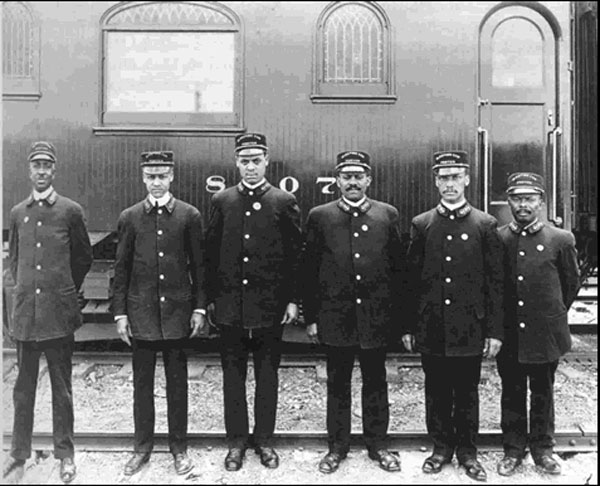
Brotherhood of Sleeping Car Porters in uniform.
On a more intimate level, we saw original photos and heard first-person, archival interviews with those who actually made the
travelers' experience so gracious, and which gave a sense of the enormous dignity and success—and spirited competition! —they
brought to their jobs as porters, cooks, and maids. Porters talked—sometimes in southern dialects pretty tricky to follow—about
carrying baggage, serving food and drinks from the dining car, shining shoes, tidying the cars of trash, mopping, cleaning windows. A fellow
who'd been in charge of making up the beds gave a precise account of the number of pillows and blankets, and exactly how he managed the
sheet around the mattress. We heard how the porters broke up blocks of ice to provide passengers with cool water by their beds, and how the
cooks, in pristine white aprons and high chef hats, put a rose on each tray of delectable food. As long as the porters were on the trains, they
might be the confidants of celebrities, politicians, and the wealthy, only to return to lower-than status when they arrived at the station.
The maids, in sleek gray dresses, modest white caps and aprons, described greeting the passengers as they boarded, escorting them to
their seats, folding their coats, refrigerating their baby formula and feeding their babies at 10:00, 2:00, and 6:00. This at a time when they
weren't allowed to look in their patrons' eyes. My favorite story came from a woman who worked the night shift: she got off work at
8:00 a.m. and hurried home in time to get her children ready for school. We heard the names of the stations on the California line
lovingly recited, names they had heard called out countless hundreds of times:
Crockett, Martinez, Tracy, Merced, Tulare, Fresno…
If there were a different production on the construction of American railways, it might tell more of the story of Blacks, Mexicans, Indigenous
Indians, Pakistanis and Chinese laborers all working together. Certainly the multitude of Chinese workers, injured, frozen and
starved—some of whom were murdered rather than paid—deserve recognition. But this wasn't that production; its focus was on "what it
meant to be a railroad man," especially for Oakland's Black Americans, with their unique history—a fascinating, complex tale by any measure.
Along with the sound of marching bands, it was in the music of Kevin Myric's sound score that we got most of the multicultural flavor of the
national railroad endeavor. The jaunty ragtime of African American Scott Joplin (d. 1917) gave us a basic feel for the era; the Indigenous
Indians were heard in the flute, the Pakistanis in the sitar. The Mexicans, it was said, called to each other and the Blacks sang, songs
that elderly speakers could still remember. We heard one example, "Hear That Train Comin' Down the Track." Across America, everyone
celebrated trains in song! A charming songstress sang multiple verses for "I Got Some People in Me." The people in her were: Irish,
Hawaiian, Chinese, German, the whole of Africa, Jewish, Arab, and Mexican.
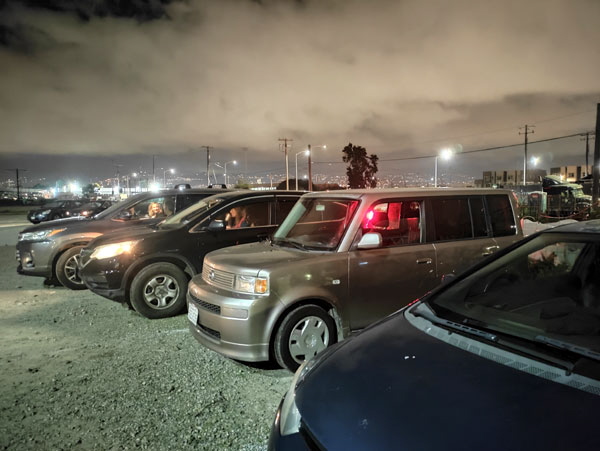
The audience. Photo by L.T. Renaud
Even though the theatres are slowly moving their audiences back inside now, I think the drive-in theatre format will endure at least as a
backup plan as we go forward, and will surely address some of its challenges over time. The sightlines weren't always perfect. With
windows required to be up, the windshield got foggy. Sound reception was hit-or-miss, and with engines off and radios on, one car's battery
died (theatre staffers immediately provided jumper cables).
The title, Binding Ties, is a pun. Writer Anne Brontë (d. 1849) first
used the phrase "the ties that bind"—nowadays it refers to invisible relationships: "ties" that connect or "bind" all people. The Southern
Pacific Railroad helped "bind" America's people with "ties"—the wooden cross pieces under the metal tracks to support them. In this
spirit of connection, our Conductor closed the show: "Oakland is some kind of town… You're all a part of it now." And we were.
* * *
BONUS IMAGES
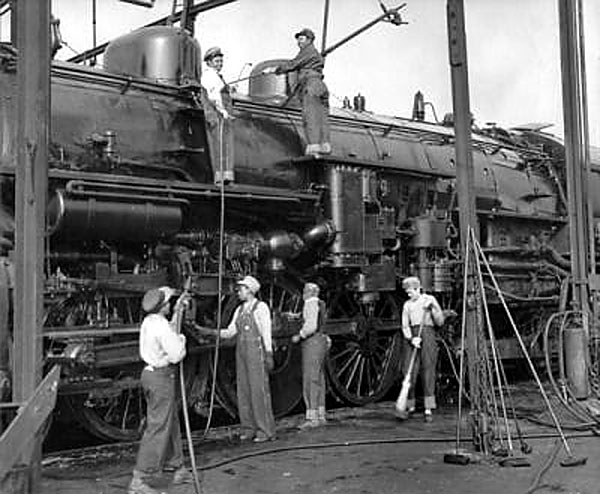
In WWI, Black women found better paying jobs on the railroads
cleaning cars, wiping engines, tending railroad beds.
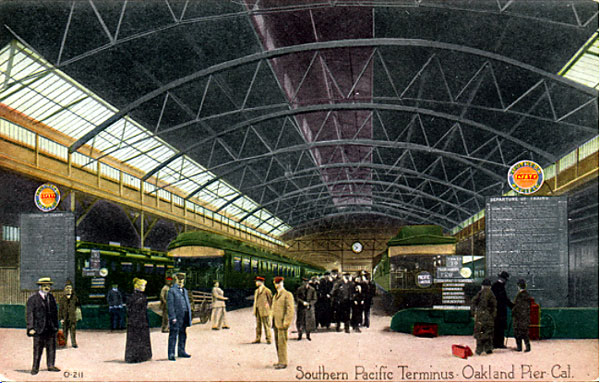
In its heyday, the Western Division of the Southern Pacific Railroad
dispatched 100s of passenger and freight trains daily from the famous Oakland Pier.
For the train lover (after an ad):
https://www.youtube.com/watch?v=-1N304T5oLw
Timestamps: 0:13 Guard's whistle 0:18 Train whistle 0:23 Train
leaving station 0:32 Train at full speed 1:02 Train passing by 1:16 Coaches passing
*
Note: An earlier version of this article appeared in Critical Stages journal of theatre criticism.
|